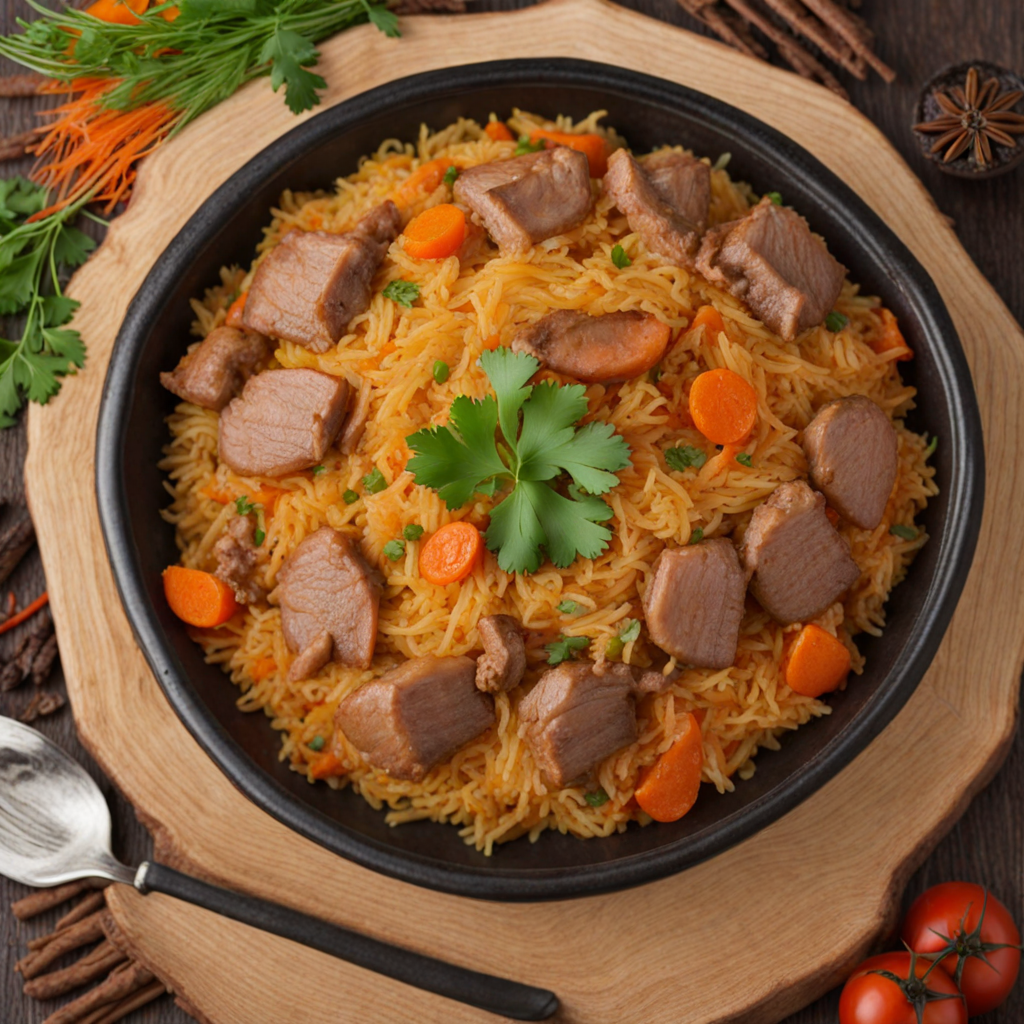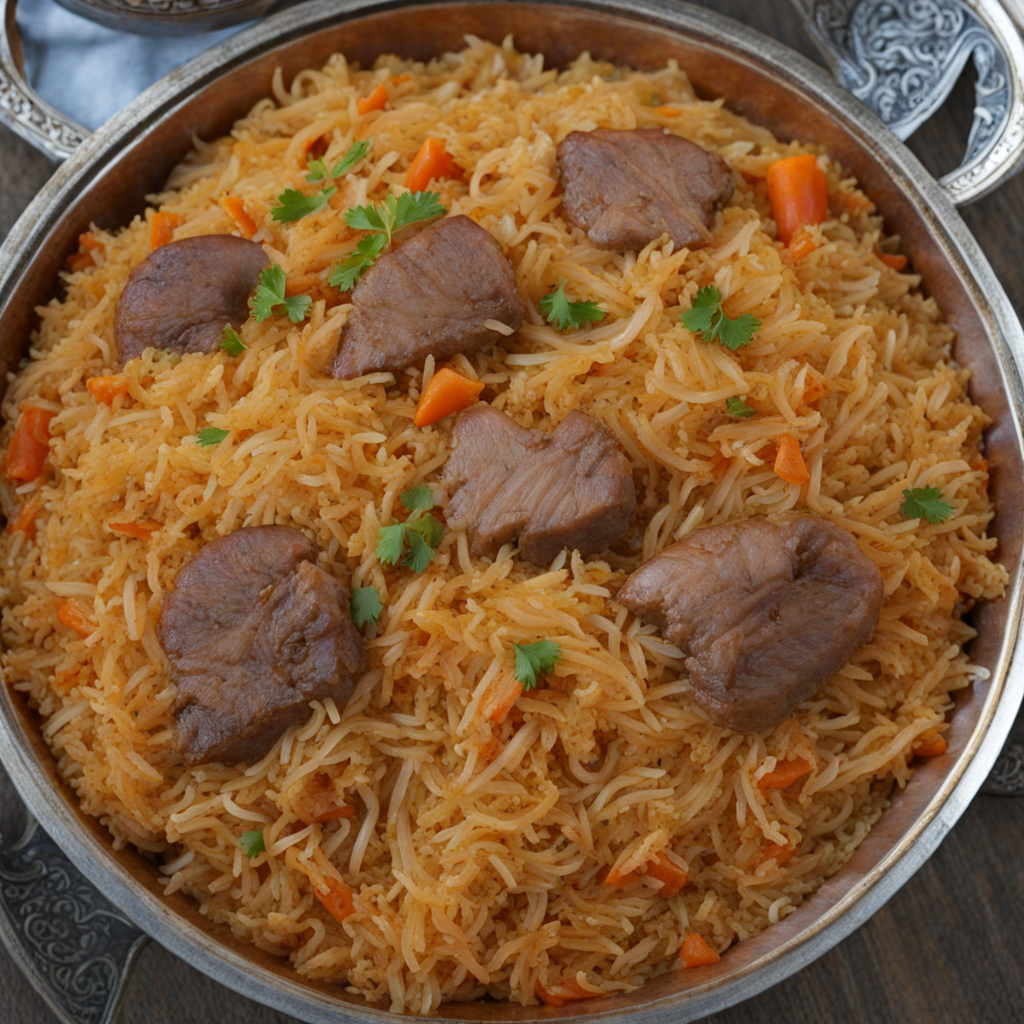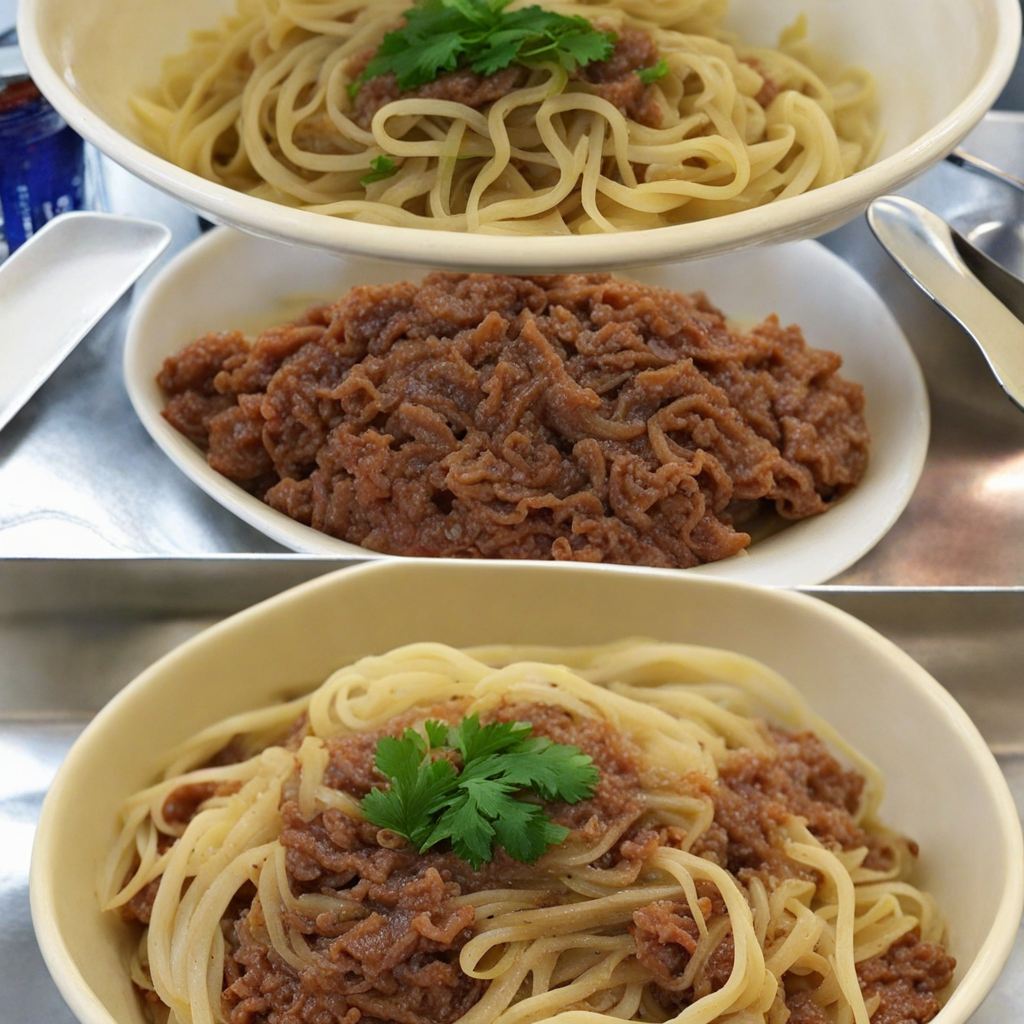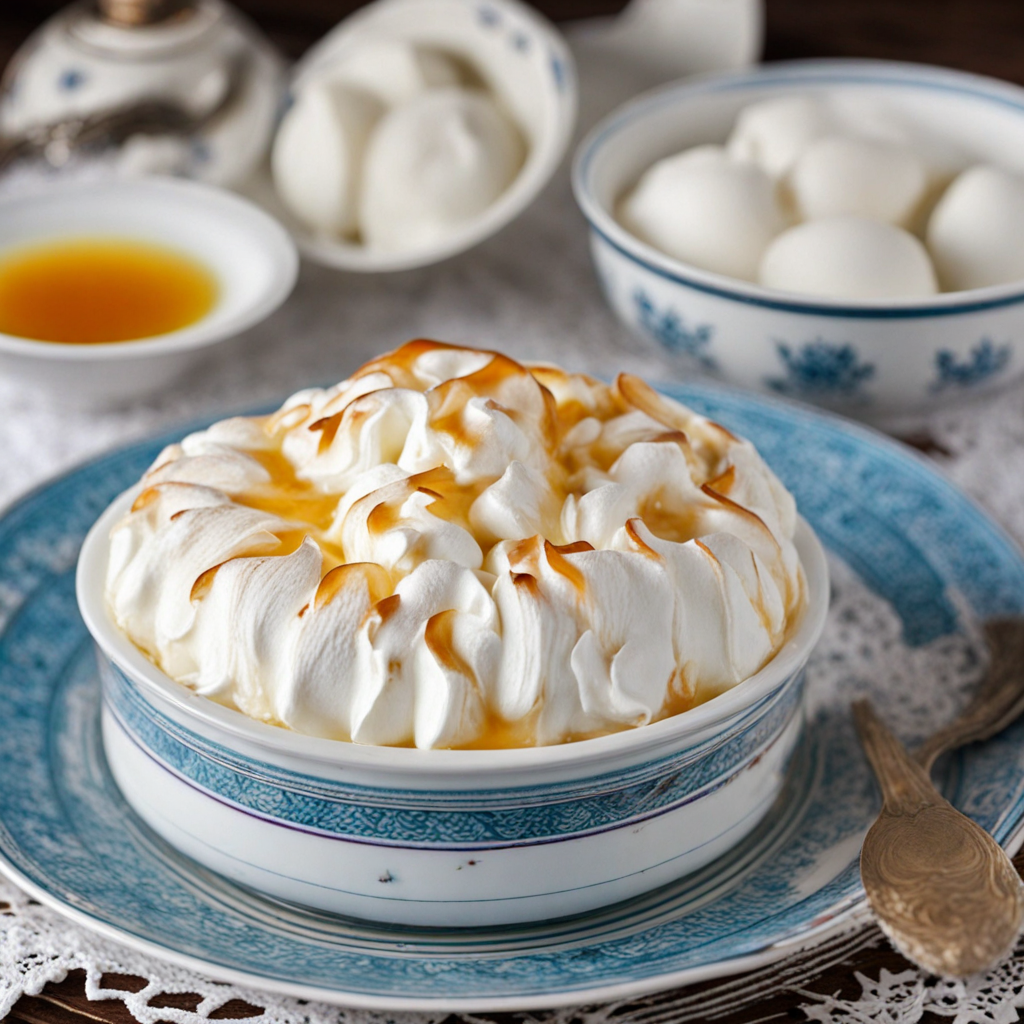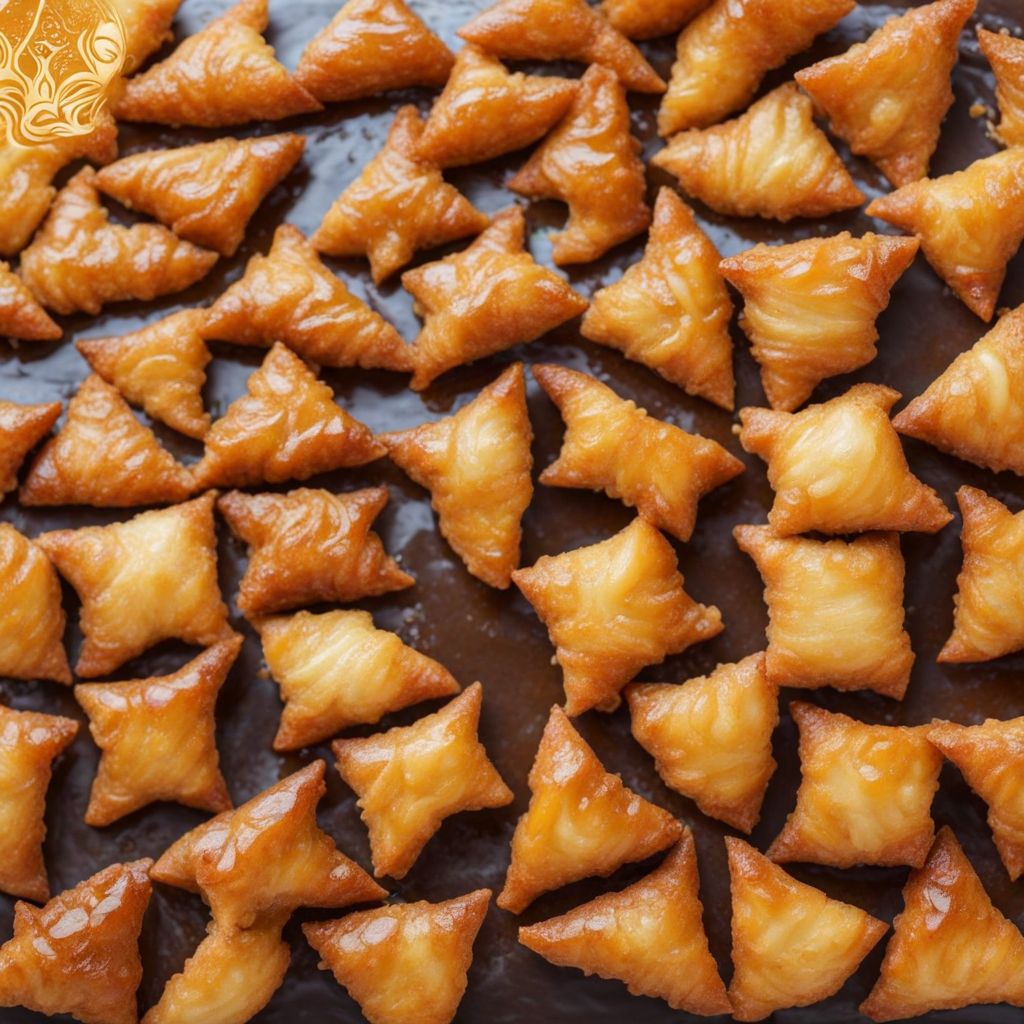Plov
Plov, a beloved dish from Uzbekistan, is a fragrant and hearty rice pilaf that captures the essence of Central Asian cuisine. At its core, plov consists of long-grain rice, usually basmati, which is cooked to perfection and infused with a medley of spices that elevate its flavor profile. The cooking process begins with sautéing meat, often lamb or beef, in a large, round kazan (a traditional cooking pot) along with onions and carrots. The combination of these ingredients creates a rich base, while the addition of spices like cumin, coriander, and black pepper adds an aromatic depth that is both warming and inviting. What truly sets plov apart is its unique layering technique. Once the meat and vegetables are cooked, the rice is added on top, along with broth or water, and then steamed to allow the grains to absorb all the savory flavors. This method results in fluffy rice that is perfectly cooked, with each grain separate and full of taste. In many traditional recipes, a variety of toppings can be added, from chickpeas to raisins, giving each serving a delightful twist that showcases regional variations. Plov is often served during special occasions, family gatherings, and celebrations, making it more than just a meal; it’s a symbol of hospitality and community. Traditionally, it is presented on a large platter, encouraging sharing and connection among friends and loved ones. Each bite of plov offers a warm embrace of flavor, transporting you to the sun-drenched steppes of Uzbekistan with its vibrant colors and rich textures. Whether enjoyed at a festive feast or a cozy dinner, plov is a dish that invites exploration and celebrates the culinary heritage of its homeland.
How It Became This Dish
The History of Plov: A Culinary Gem from Uzbekistan Plov, known as "pilaf" in many cultures, is a quintessential dish of Uzbekistan, steeped in a rich tapestry of history, culture, and tradition. Characterized by its fragrant rice, tender meat, and a medley of spices, plov is more than just a meal; it is a symbol of hospitality, community, and cultural identity in Central Asia. #### Origins The origins of plov can be traced back over 1,000 years, with roots in the ancient Persian empire. The dish is believed to have evolved from the Persian "polo," which referred to rice cooked with meat and spices. Historical texts suggest that as trade routes flourished along the Silk Road, culinary practices and recipes migrated alongside merchants, giving rise to regional variations. In Uzbekistan, plov became a staple food, particularly among nomadic tribes. The dish was practical for the harsh conditions and the necessity of feeding large groups of people, such as during gatherings, weddings, and celebrations. The nomadic lifestyle required meals that could be prepared with minimal resources while still being nourishing and satisfying. #### Cultural Significance Plov holds a revered place in Uzbek culture. It is not merely a dish; it embodies the values of community, generosity, and tradition. In Uzbek society, plov is often prepared during significant life events, such as weddings, birthdays, and religious festivals. The act of making plov is a communal affair, often involving family and friends who gather to share in the preparation, which fosters a sense of togetherness. The preparation of plov is an art form in itself. Traditional recipes are passed down through generations, with each family adding its unique twist. The process begins with selecting the right ingredients: long-grain rice (often basmati), tender cuts of meat (typically lamb or beef), onions, carrots, and an array of spices, including cumin and coriander. The rice is usually cooked in a deep, heavy pot called a "kazan," which allows for even heat distribution and enhances the flavors. Plov is often served at the center of the table, where guests are invited to help themselves, symbolizing the importance of sharing and hospitality in Uzbek culture. The presentation of plov is an integral aspect, as it is arranged in a visually appealing manner, sometimes adorned with garnishes such as chickpeas or barberries, showcasing the culinary artistry of the cook. #### Development Over Time As Uzbekistan underwent various political and cultural transformations, so too did plov evolve. The spread of Islam in the region influenced not only culinary practices but also the ingredients used in plov. The adaptation of the recipe to include halal meats and spices reflects this change. The dish also gained regional variations, with different areas of Uzbekistan boasting their unique twists on plov. For instance, in Samarkand, plov may include dried fruits like raisins, while in Bukhara, it might be enriched with saffron for a distinct flavor. During the Soviet period, plov became a symbol of national identity amid the cultural homogenization imposed by the regime. Soviet authorities promoted plov as a national dish, further embedding it in the national consciousness. It was during this time that the dish gained international recognition, with restaurants and cafés across the Soviet Union serving their versions of plov, albeit often simplified. In the post-Soviet era, Uzbekistan experienced a cultural revival, leading to a resurgence of interest in traditional foods, including plov. Chefs began to experiment with new ingredients and methods, while simultaneously honoring time-honored practices. This renaissance also saw the rise of plov festivals, where cooks compete to create the best plov, celebrating both the dish's heritage and its contemporary interpretations. #### Regional Variations While the essence of plov remains consistent, regional variations showcase the diversity of Uzbek cuisine. Each region boasts its unique style of plov, often reflecting local ingredients and culinary traditions. - Tashkent Plov: The capital's version tends to be simpler, with a focus on the core ingredients of rice, meat, and carrots. Often, it is served with a side of salad to complement the dish. - Samarkand Plov: Known for its vibrant flavors, this version may include dried fruits like apricots or raisins, giving it a sweet note that contrasts with the savory elements. - Bukhara Plov: This variation is frequently enriched with saffron, adding a luxurious touch and a rich golden hue to the rice. It is also known for its use of chickpeas, which add a hearty texture. - Ferghana Plov: In the Ferghana Valley, plov may include additional spices and a mix of vegetables, showcasing the local agricultural bounty. #### Plov in Contemporary Culture Today, plov continues to be a symbol of Uzbek hospitality and identity. As Uzbekistan opens up to the world, plov has found its way into international culinary circles, with chefs and food enthusiasts seeking to explore the authentic flavors of Central Asia. Modern Uzbek restaurants have sprung up in cities around the globe, introducing plov to a wider audience and celebrating its cultural significance. Moreover, plov has become a source of national pride for Uzbeks. In 2021, Uzbekistan sought to have plov recognized by UNESCO as an Intangible Cultural Heritage of Humanity, emphasizing its role in fostering cultural identity and community bonds. This initiative underscores the importance of preserving traditional culinary practices in an increasingly globalized world. #### Conclusion Plov is more than a dish; it is a narrative woven into the fabric of Uzbek culture and history. From its ancient origins along the Silk Road to its status as a beloved national dish, plov reflects the resilience and diversity of the Uzbek people. As it continues to evolve and adapt, plov remains a symbol of hospitality, tradition, and cultural identity, inviting all who partake in it to share in its rich history and the stories it tells.
You may like
Discover local flavors from Uzbekistan


